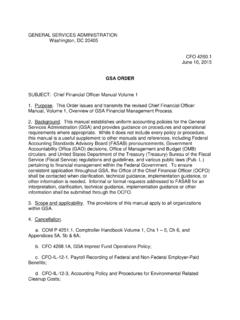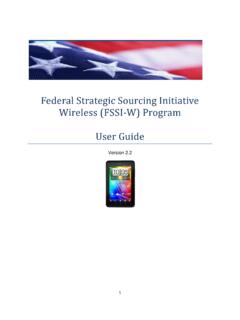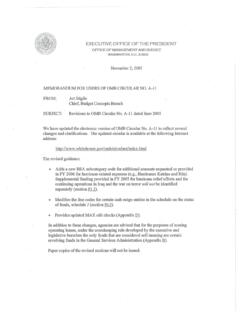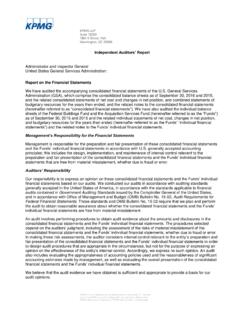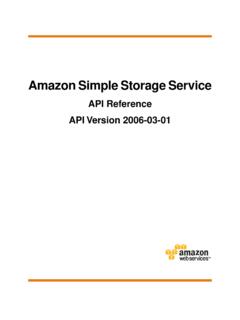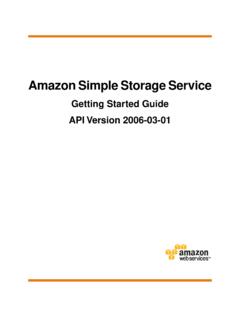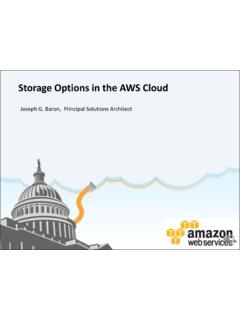Transcription of Hybrid IT Strategy Benefits, Use Cases, and Risks
1 1 Hybrid IT Strategy benefits , use cases , and Risks General services Administration Federal Acquisition Service, Cloud PMO February 2016 2 Table of Contents I. EXECUTIVE SUMMARY II. DISCUSSION a. What is a Cloud and what Cloud Strategy is Best? b. use cases and benefits of Hybrid IT c. Risks of Hybrid IT III. RECOMMENDATIONS FOR BUILDING A Hybrid CLOUD REFERENCES 3 I. EXECUTIVE SUMMARY When agencies find that they cannot migrate all IT infrastructure including legacy, applications or data to the public cloud, a blend of public and private cloud may be considered. Cloud Service Providers (CSPs) refer to this as a Hybrid cloud. Migration to Hybrid cloud should be done if tangible benefits may be achieved.
2 Migrating to a blend of public and private cloud may help agencies sufficiently protect sensitive or classified data and still demonstrate compliance with OMB s Cloud First policy. To ensure proper justification of cloud migration, agency CIOs may wish to seriously consider the use case for the workload of the application and comparing it to the option of leaving software running as is or migrating to a combination of private and public cloud infrastructure. Agency CIOs should ensure they identify the operational and business benefits of implementing a Hybrid cloud and build the business case 1 to support their Strategy . II. DISCUSSION a. What is a Cloud and what Cloud Strategy is Best?
3 As defined in NIST Special Publication 800-145, a cloud is a commercially provided IT service that must possess five essential characteristics such as on-demand self-service, resource pooling, rapid elasticity, measured service, and broad network access. Federal IT stakeholders may wish to consider their cloud Strategy , roadmap, and respective cloud deployment status. Secondly, stakeholders are encouraged to 1 A study by several IT analytic firms found that major CSPs offering Infrastructure as a Service (IaaS) typically cost more than CSPs offering Private Cloud services once they reach about $7,000 in cost per instance.
4 Research studies also found that if operations require 24x7x365 availability, it may be more cost-efficient to only host IT environments in a private cloud unless a CSP offers significant volume discounting. 4 consider whether the agency wishes to move all data and applications to the public cloud, the private cloud, or a split between the two to achieve the best degree of agility, elasticity/scalability, and availability in addition to the best protection of any sensitive data. Government IT leaders should know before contracting with a vendor whether they want a public, private, or Hybrid cloud. A public cloud is one based on the standard cloud computing model, in which a service provider makes resources, such as applications and storage , available to the general public over the Internet.
5 Public cloud services may be free or offered on a pay-per-usage model with a greater number of computing resources that may be provisioned to meet varying workload demand than other delivery models, and may cost less than public clouds. In a private cloud model, scalability and self-service are featured characteristics not unlike the public cloud, yet private cloud carries a proprietary architecture. Contrary to public clouds, which deliver services to multiple organizations, a private cloud has computing resources dedicated to a single organization. However, many internally designed and implemented private clouds fail as they are often unable to scale or meet growing security requirements.
6 In a Hybrid cloud model, orchestration exists between public and private clouds. Agencies can run mission-critical workloads or sensitive applications on the private cloud while using the public cloud for high volume workloads that must scale on-demand. Acquisition stakeholders should carefully consider the inherent functions of their agency when selecting a cloud type to ensure an appropriate level of policy and governance. Implementing a Hybrid model may require a fine balancing of security, achievable compliance levels, accessibility, computing and financial resources. However, Hybrid models can leverage cloud management platforms (CMPs) to ease the burden of balancing security and thereby ensure optimum benefit and control is exerted.
7 CMPs can also help identify and manage the prevalence of shadow IT, and is often deployed in SaaS instances. b. use cases and benefits of Hybrid IT By allowing workloads to move between private and public clouds as computing needs and costs change, Hybrid cloud gives businesses greater flexibility and more data deployment options. For example, an enterprise can deploy an on-premises private cloud to host sensitive or critical workloads, but use a third-party public cloud provider, 5 such as Google Compute Engine, to host less-critical resources such as test and development workloads. To hold customer-facing archival and backup data, a Hybrid cloud could also use amazon simple storage Service ( amazon S3).
8 A software layer, such as Eucalyptus, can facilitate private cloud connections to public clouds, such as amazon Web services (AWS). Hybrid cloud is particularly valuable for dynamic or highly changeable workloads. For example, a transactional order entry system that experiences significant demand spikes around the holiday season is a good Hybrid cloud candidate. The application could run in a private cloud, but leverage public cloud computing resources (for additional cost) when computing demands spike. To connect private and public cloud resources, this model requires a Hybrid cloud environment. Another Hybrid cloud use case is big data processing. A company, for example, could use Hybrid cloud storage to retain its accumulated business, sales, test and other data, and then run analytical queries in the public cloud, which can scale to support demanding distributed computing tasks.
9 In comparison, a private cloud, may not always have the scalability necessary to handle the workload needed to achieve an agency s desired results, measurable objectives, or business goals. Many agency cloud environments are still evolving. However, most large agencies are using a mix of private and public commercial clouds for a variety of workloads, such as email and collaboration, content management, test and development, big data analytics and even security. Hybrid IT solutions offer the benefit of Cloud storage Gateways which may also help agencies store data where rapid elasticity is valued. Finally, a Hybrid IT Strategy relieves agencies of the burden of retaining trained staff to manage data centers or on premise application hosting environments.
10 CSPs take on that responsibility, or enable the customer to control the network at the SaaS or PaaS level. When moving forward, achieving the ability to virtualize the network is the first step. Virtualization, a means of partitioning servers and operating systems to share computing resources and applications across multiple users, has expanded throughout the infrastructure, from computer to storage to the network layer. Virtualizing the network is a critical next step toward the evolution of the Hybrid cloud, according to Doug Bourgeois, Vice President of End-User Computing with VMware Public Sector. Virtualization at the network layer allows managers to disconnect the application from the physical network.


